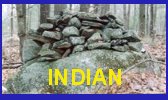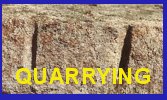



 |
 |
 |
 |
|
|
|
|
|
Printer Friendly Version (PDF) Introduction The Flynt Quarry in Monson, Massachusetts has the largest known collection of unusual quarry drill marks known today as “star holes.” [FT 1] The five pointed version of the “star hole” is sometimes called a “pentagonal hole.” A number of examples may be found on the smooth white bedrock floor of the eastern most section of the quarry. These may be examined safely without any rock climbing. Star holes are quite rare. Currently, only a small number of other examples have been reported from locations in New England. A single example was found in one of the large stone blocks forming the breakwater on the southern side of Ordione Point in Rye NH, one star hole and three round 3 inch diameter blast holes were drilled into a glacial erratic in the Johnston Town Forest in RI, one example from Newbury MA, at least one example from Hoosac Tunnel in Massachusetts, and one example from a guano covered boulder in Little Pleasant Bay on Cape Cod. Description Star holes, are holes drilled in rock that when viewed from the top (i.e. cross-section) look like a five or six pointed star. The “points” of the star holes can be either rounded lobes or V-shaped points with rounded tips. The rounded points are actually longitudinal grooves inside the drilled hole. The grooves spiral inside the hole giving the hole the appearance of being the inside of a rifle barrel. These grooves can be seen in some of the long vertical drilled holes found on the walls of Flynt Quarry. These may safely be observed by walking along the base of the quarry walls. These holes were used to separate large blocks of rock from the bedrock by blasting. When these rifled grooves occur, they only occur over part of the total length of the drilled hole. The remainder of the drill hole has the typical round cylindrical shape. The length of the rifled grooves and their position (i.e. top, middle, or bottom) in the hole varies considerably with each drill hole. The number of grooves, the width of the grooves, the direction of the grooves (left or right spiral) and the number of turns per foot can vary as well. So far, the rifling effect has only been documented in machine drilled holes with a diameter of 2 inches or more. It only occurs in a minority of the large diameter drilled holes. The majority of the large diameter holes are round.
Map of the Flynt Quarry
Figure 1 - Five Point Pentagonal or Star Hole (Flynt Quarry Monson MA)
Figure 2 - Six Point Star Hole (Flynt Quarry Monson MA)
Figure 3 - Close-up showing the riffled channels (Flynt Quarry Monson MA) Previous Research A search of the historic literature on quarrying and mining failed to locate any references to this rifling effect in machine drilled holes used for blasting. However, the search did uncover a detailed discussion of the rifling effect in core sample drilling. Although blast hole drilling and core sample drilling used two very different types of drill bits, both have produced similar types of rifled holes. Therefore, the research on core drilling is applicable to quarry star holes. In the early 20th century, the rifling effect was occasionally observed on rock core samples obtained using diamond drills. Diamond drills had a drill bit in the shape of pipe coupling which was studded with a number of industrial diamonds. The bit was hollow allowing for a cylindrical core of rock to be cut loose and removed from deep within the test hole. (In contrast, the quarry drill bits were two crossed cutting edges arranged in a + configuration. The cutting edges pulverized the rock which was then blow out of the hole with compressed air). With the core samples, the spiral grooves appeared on both the outside of the sample as well as on the walls of test hole. Like the quarry blasting holes, the spiral occurred only on a short section of the core. The remainder was your typical round drill hole.
Figure 4 - Diamond core drill bits with an example of a rifled rock core. In 1916, Dr. Walter Crane [FT2] presented a paper on the subject of rifled core samples at the American Institute of Mining Engineers conference. He began is research by sending inquiries to major diamond drilling companies and engineers familiar with diamond drilling operations asking for their observations and opinions on how the rifling occurred. According to Crane, “The concensus of opinion obtained from the replies received was that vibration is responsible for the phenomena.” (p.99) To test the hypothesis that vibration was responsible for the rifling effect, Crane conducted a series of experiments. He attached one end of a metal pipe to a lathe and left the other end free. This arrangement allowed the pipe to vibrate. A cutting bit was attached to the lathe to simulate the diamonds on the drill bit. Crane was able to easily recreate the rifling effect. Based upon the results of the experiments, Crane drew the following conclusion: The phenomena of rifled cores are due to torsional vibration of the drill rods, which in turn is produced by the rotation of the rods. The cutting medium attached to the rods engages with the core, penetrating to a certain depth, and thereby temporarily checking the rotation of the rods. When the energy stored up in the rods by the torsional strain exceeds the frictional resistance between the cutting medium and the core, it forces the cutting point out and the rod springs around until the strain is relieved, the action being repeated uniformly and indefinitely. The depth to which the cutting point enters the core depends upon its size, shape, and hardness, and upon the hardness of the core, also upon the intensity of the vibration. The distance through which the cutter rotates between points of contact with the core determines the number of threads to the turn, but it is probable that the number once established predisposes its regularity and symmetry. With lower speeds of rotation the vibration is less intense and the cutting point remains in contact with the core for a longer period; the number of threads to the turn as well as the pitch of the threads may be changed in this manner. (Crane 1917, 107) H. M. Roberts commented at some length on Dr. Crane’s paper in a letter published as part of the conference proceedings. Roberts added some observations in addition to those made by Crane. He noted that (1) the diamond bits which cause rifled holes showed extensive wear causing the diamonds (i.e. cutting edges) to protrude further out of the metal; (2) the depth of the hole is not a factor; and (3) rifling only occurs over a homogenous section of rock (the rifling stops when the type of rock changes). Roberts agreed in principle with Dr Crane’s findings but was of opinion that a more detailed scientific explanation of how the vibrations caused the rifling effect was needed. Roberts argued that rifling was the result of “torsion vibration” in combination with “harmonic motion.” In support of his argument, he wrote: The presence of threads over any interval of core indicates a constant play to and fro of the bit relative to the axis of the hole during its advance. Uniformity of the threading over any interval of core indicates that the swing of the bit operates according to some law. The fact that the number of threads and their character change from interval to interval, indicates that the factors causing the swing of the bit vary in considerable degree. We are evidently dealing with some type of harmonic motion. … Consider the forces that operate on a flexible line of drill rods which are revolving rapidly: First, compression; second, torque. The play of these two forces sets up waves which have their lengths parallel but twisted with respect to the drill rods and with their crests and troughs at right angles to the axis of the hole. … As the rods revolve, transverse waves advance down the rods at every azimuth, like waves of light. … It is possible to count distinct beats in the play of the swivel to and fro as the rods vibrate. The regularity of the grooving in the threaded core indicates that the waves producing it have a definite time interval with a fixed relation to the revolution of the rod. ... In the instance cited by Dr. Crane where pentagonal core is formed, the time of vibration must be nearly a definite divisor of the time of revolution. That is, during one revolution of the bit there were approximately five major wave motions which produced a portion of five threads on the core … (Crane 1917, 112) According Roberts, the spiraling of the grooves was the result of the major wave motions occurring slightly earlier or later during the rotation of the bit. A left hand spiral was due to the wave motion being slightly earlier and the right spiral due to the wave being slightly later. To prevent excessive vibration and rifling of the holes, Roberts recommended using new drill bits and stiff new drill rods. He also noted that greasing the drill rods and varying the rotational speed were effective in dampening any harmonic vibrations as well. Discussion Crane and Roberts’ research offers a scientific and logical explanation for why and how the rifling effect occurs. Their research demonstrated that vibrations during drilling caused harmonic waves to be transmitted down the drill rod resulting in the drill bit swaying back and forth with the crests and troughs of the wave. The back and forth motion of the bit forces the cutting edges to cut half circular gouges in the wall of the hole. Because the harmonic motion vibrates at a uniform rate in relation to the rotation of the bit, the bit hits the wall in the same places during each rotation. Since the bit cuts slightly deeper with each rotation, the bit gouges the wall in the same horizontal places but slightly further down in the hole from the gouges in the previous rotation. The net result is the formation of continuous channels. Basically, the rifled star holes are the result of the drill bit chattering in the hole. The chattering was most likely the result of several factors including the vibrations caused by the drilling machine, a dulling bit, metal fatigue in the drill rod, and the rotational speed of drill. The rifling was an unintentional and undesirable side effect of excessive vibration during the drilling process. Footnotes Footnote 1 - The Flynt Quarry is owned by the Town of Monson and Opacum Land Trust. It is located on Margaret Street and is open to the public for hiking and exploration. Footnote 2 - Dean of the School of Mines, The Pennsylvania State College. Bibliography Crane, Walter R. |
|
|
|||||||||
 |
|||||||||
|
|
|||||||||
 |
|||||||||